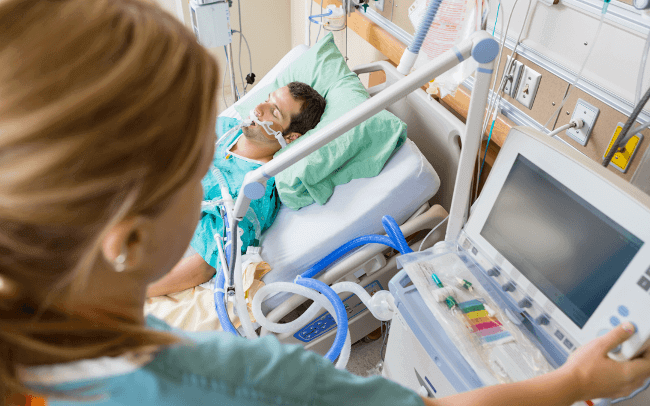
Intensive Care and Ventilation Therapy
Gas exchange is continued artificially by means of a machine until the factors that cause respiratory deterioration are eliminated. Patients should be monitored and treated by a team specialized in this field. Observation and care criteria of the patient in mechanical ventilation should be known and nursing care should be planned and maintained in accordance with patient needs. The goals to be achieved in the care of the patient in mechanical ventilation can be listed as follows. Ensuring Adequate Ventilation - Breath sounds should be evaluated, and the compatibility of chest movements with the ventilator should be observed. - Attention should be paid to the patency of the airway and aspiration should be performed when necessary. - Extremities should be evaluated in terms of color and temperature. - The oxygen given to the patient should be heated and humidified by an external source. Humidifier temperature and water level should be checked; excessive humidification increases the resistance of the respiratory tract, impairs the oxygenation of the blood, and may cause water intoxication in patients with water restriction. Too little increases crust formation and causes drying of the respiratory tract. - Blood gases taken by the doctor should be evaluated and electrolyte monitoring should be performed. - The patient's vital signs, general condition, intake and output should be constantly monitored and recorded. - Frequent position changes should be made to prevent secretion stasis. If the situation allows, breathing exercises should be done. - FiO2, tidal volume, minute volume, expiratory and inspurium airway pressures, PEEP and IMV values, alarm limits should be known and checked frequently. - Mechanical ventilation problems and interventions If the mechanical ventilator gives a high pressure alarm; - Check whether the ventilator connections are crimped and correct if necessary. - It should be checked that the endotracheal tube does not slip, and attention should be paid to the position of the patient. - If the patient is awake and his breathing coincides with the ventilator, the ventilator mode should be changed or sedation should be provided upon the request of the physician. - Whether there are factors that may cause agitation such as pain, fear and hypoxia should be determined and interventions should be made to address the cause. - Obstruction of the airway should be observed, if necessary, it should be aspirated. If the mechanical ventilator gives a low pressure alarm; - Connections should be checked, and if there are leaks, appropriate attempts should be made. - It should be checked whether there is a malfunction in the ventilator, if so, the technical service should be informed and it should be replaced with a spare. - If this problem has developed due to the patient's fatigue, the ventilator mode should be changed according to the physician's request. - Cuff pressure should be checked, inflated if it is low, and if there is a leak, the tube should be replaced. - The patient should be observed for gastric distension, and if necessary, appropriate interventions should be planned to eliminate this problem. If the mechanical ventilator gives a low volume alarm; - Alarm limits should be checked. - The position of the tube should be evaluated and any bends should be corrected. - Ventilator connections and cuff pressure should be checked. - The problems of the mechanical ventilator should be known, the patient should be observed for possible problems and the alarm should never be turned off before the cause of the alarm is found. - Minimizing the risk of infection - The patient should be aspirated in accordance with the sterile technique, and the secretions should be evaluated in terms of color, density and amount. - Tracheal aspiration and other necessary cultures should be taken and sent at regular intervals. - Maintenance and replacement of the ventilator's connections should be done at frequent intervals. - The water level of the humidifiers should be checked, sterile distilled water should be used and attention should be paid to the cleanliness of the humidifiers. - Oral care should be given at frequent intervals. - Incompatibility with mechanical ventilator and Anxiety - The patient should be told at the first opportunity where he is, why he needs a ventilator, and when he can leave. - Necessary training should be given to the patient about compliance with the ventilator, signs of anxiety should be observed (high pressure alarm, crying, etc.), sedatives should be administered if necessary according to the physician's request. - Intensive care, ventilator and applications should be explained to the patient's family. Extubation Process - Extubation should be started early in the day. - The patient should be informed about the procedure - Head and torso should be raised 45 degrees - Vital signs and arterial blood gas sample should be taken - Ambu and oxygen systems should be prepared - Intubation instruments should be prepared on the patient's head - The airway and the oropharynx above the balloon should be carefully aspirated. - The balloon of the intubation tube is deflated, the tube is removed and high concentration oxygen administration is started. - The number of the removed tube should be recorded in the patient file. - The patient should be given coughing exercises - Arterial blood sample should be taken from the patient 10 minutes after extubation and the patient's blood gas should be evaluated. - The patient's vital signs and general condition should be continuously evaluated and if any changes occur, the physician should be informed. Tracheal Aspiration Irritation of the trachea by the endotracheal tube


